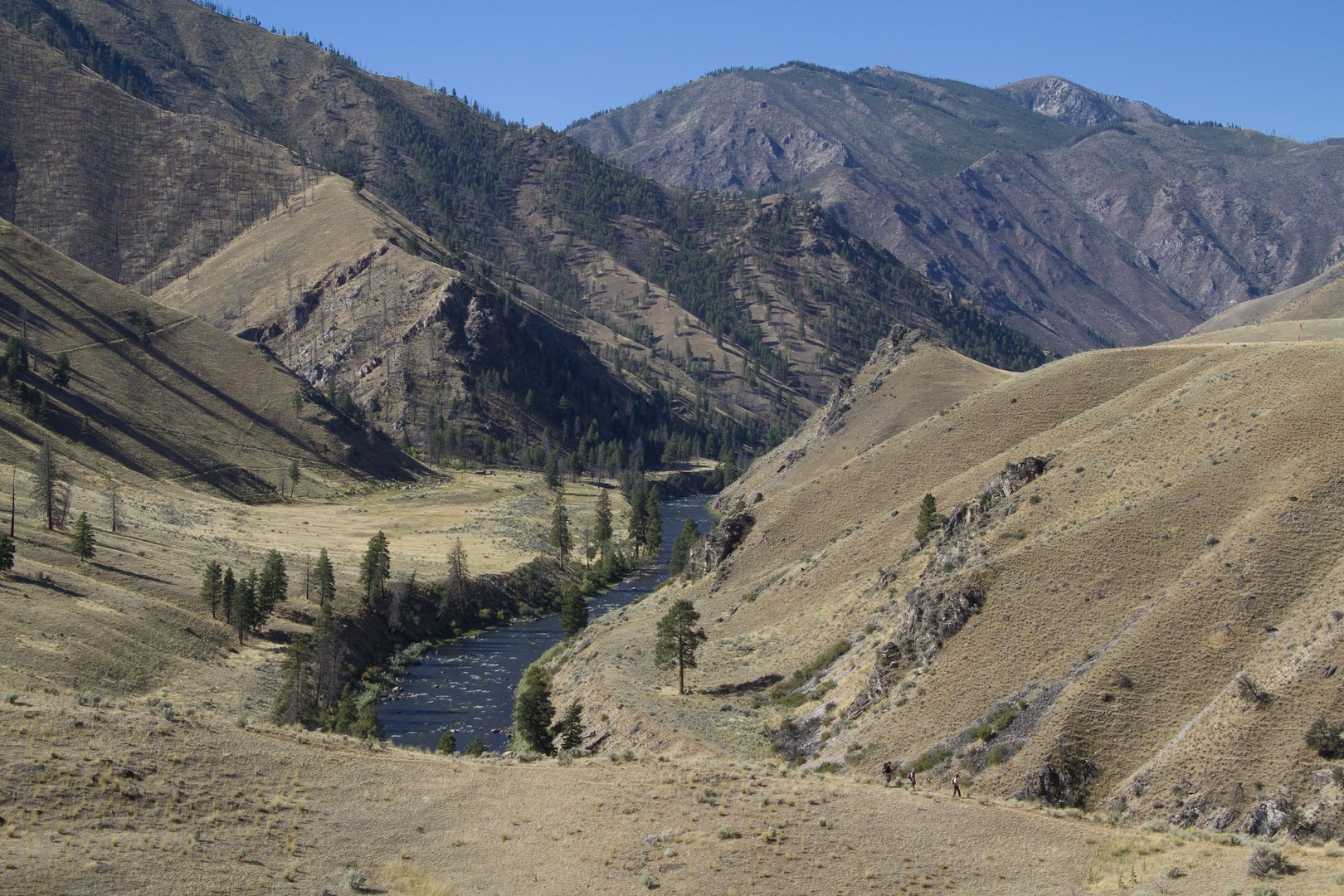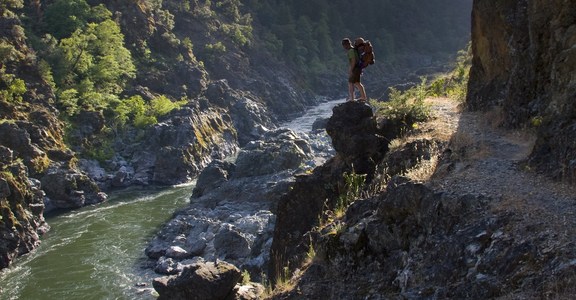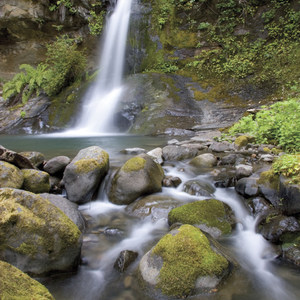Middle Fork of the Salmon River Trail - Overview Info
Middle Fork of the Salmon River Trail - Overview Info
The Middle Fork of the Salmon Trail parallels the river from Boundary Creek (RM 0) to the Big Creek Bridge (RM 77.8). Side canyon trails join the main system in many spots, and at times there are trails on both sides of the Middle Fork. Miles indicated in the title and throughout the text use river miles (RM). Though the trail covers more linear distance, the best map labels mileage in reference to floating the river corridor.
These descriptions are from a raft-supported Middle Fork hiking trip and are intended to provide a description of a typical day along the entire length of the Middle Fork Trail. While this trip is easily accomplished with raft support, backpackers will be carrying considerably more weight and will have to come up with a different plan for egress from the canyon. One option would be to charter a flight out of the canyon from the Flying B Ranch (RM 66.5). Alternately, one can hike out through either Big Creek (river left) or the Big Horn Crags (river right) once the trail leaves the Middle Fork at the Big Creek Bridge (RM 77.8).
In addition, backpackers will have more flexibility with their campsite selection and itinerary as they are not assigned specific campsites along the river. For more information about permits and wilderness regulations visit the Middle Fork Ranger District website.
For more general information about rafting the Middle Fork of the Salmon read this informative Middle Fork overview.
To avoid redundancy, these hiking descriptions focus on the particulars about the trail/hiking experience. Additional Outdoor Project adventures covering each day of a six-day Middle Fork float that include a detailed landscape description can be found here:
Middle Fork of the Salmon River – Day 1 - Boundary Creek Launch (RM 0) to Sheepeater Camp (RM 13.3)
Middle Fork of the Salmon River – Day 2 - Sheepeater Camp (RM 13) to Marble Creek Camp (RM 32.4)
Middle Fork of the Salmon River – Day 3 - Marble Creek Camp (RM 32.4) to Shelf Camp (RM 48.9)
Middle Fork of the Salmon River – Day 4 - Shelf Camp (RM 48.9) to Driftwood Camp (RM 71.6)
Middle Fork of the Salmon River – Day 5 - Driftwood Camp (RM 71.6) to Otter Bar Camp (RM 90.5)
Day 4 - Upper Jackass Camp (RM 38.1) to Cougar Creek Ranch (RM 41.3)
After three days of hiking on trails with moderately challenging conditions (rock talus crossings, post-fire impacts), day four offers some of the smoothest walking. Not surprisingly, it is also the least rugged portion of the entire Middle Fork canyon. The underlying geology is composed of a pinkish erodible granite known as the Casto pluton. The resulting landscape is one of gentle (relatively speaking, the canyon is still 3,000-feet deep) sloping walls and a wider canyon bottom that can accommodate larger alluvial fill terraces.
After climbing to the high, narrow bench above Upper Jackass camp, the trail traverses beneath a huge face that was severely burned in 1979 during the Mortar Creek Fire. Though there are a few pockets of trees that survived, the rest of the face has not sprouted any evergreen trees. The handful of living green trees among the shrubs, grasses, and ghostly dead trunks is actually quite pretty. Perhaps the lack of evergreen regrowth, especially in the lower elevations of the canyon, is indicative of a warming planet and shifting vegetation patterns?
The trail continues across several different terraces levels and passes beneath a small cliff outcropping of the pink Casto pluton. Look for pictographs on the cliff wall and some pit depressions along the edge of the terraces left by the Sheepeater peoples who lived in the canyon for thousands of years.
After crossing Little Loon Creek (you will need to remove your shoes to keep them dry), the trail continues across more flat terraces for another mile or so to a second and smaller crossing at Cougar Creek. Take some time to visit the Dutch John Helmke’s Cabin at the mouth of Cougar Creek.
Dutch John Helmke arrived in the Middle Fork country in 1901. He settled on Cougar Creek in 1908 and cultivated hay, vegetables, and strawberries for sale to the Loon Creek miners. The ranch was purchased in 1924 by Charley and Wilma Warnock. They ran cattle on the grassy flat here and downstream at the Mahoney Ranch, which they also owned. Charley was a packer and worked for the Zane Grey expedition into the Middle Fork in the 1930s. The Warnock’s eventually sold the property to the Fish and Game Department.
Cougar Creek Ranch (RM 41.3) to Whitey Cox (RM 46.8)
The smooth and pleasant walking of day four is countered by two large climbs above the river before reaching Whitey Cox Camp and pool for lunch. Look for the trail on the hillside behind the Cougar Ranch Cabin. It traverses the base of the hillside across the broad, open bench where Dutch John grew hay and the Warnocks grazed their cattle. There are no trees for shade as the trail climbs a narrow ridge through a grassy switchback to a high point above Mahoney Camp (RM 42.2). The view upstream of the river meandering alongside the grassy bench and cabin tucked beneath a backdrop of high, forested peaks is stunning.
From the top of the first climb hikers descend only slightly though rolling, grassy hills before holding a high traverse above Pine Flat Camp (RM 43.8) to an overgrown crossing of an unnamed creek. Note that a spur trail drops to the camp, and there are some great swimming holes below Pine Flat Rapid. This area was impacted by wildfires in 2007. Though the grassy hillsides have recovered completely, there are still several pockets of burned out trees that indicate how hot the fires burned.
The trail turns away from the river up Red Bluff Creek (RM 44.9) for several hundred yards before wrapping into a long, loose, and open switchback that leads to the top of Red Bluff Rocks. This 200-foot cliff rises out of the water and forces the trail high above the river. A short section of exposure at the top of the climb will give some hikers pause, while others will enjoy the expansive view upstream. The trail is a little faint on the switchbacking descent through pockets of burned trees, but continue on a downward trend toward the river to find it on yet another open, alluvial terrace.
A short, steep side hill with nice views onto the water above Culver Creek (RM 46.1) connects to another open terrace that leads toward Whitey Cox Camp. The river trail actually cuts inside above the camp and hot spring (watch out for red spider mites), so look for braided trails that lead past the hot spring seep and Whitey Cox’s gravestone down to the large gravel bar and swimming hole.
Whitey Cox (RM 46.8) to Big Loon (RM 50.1)
Downstream from Whitey Cox the trail traverses high above the river through a pocket of north-facing forest that survived the burn in 2007. For the next several miles to Big Loon the trail alternates between fire-killed trees, open grassy slopes, and shady Doug fir and ponderosa pine forests. An opportunity to jump from the White Creek Bridge (RM 48.8) is tempting for some, while others may be looking forward to a soak in the Loon Creek Hot Springs. The final mile can be a little hot and dusty, but it enters the shady forest along the rushing Loon Creek.
There is a nice backpackers campsite on a bench above Loon Creek where the mouth of the canyon narrows. At the end of the day hikers will have two options. The first is to continue another half mile past the bridge over Loon Creek to soak in the man-made hot springs tub. Otherwise, they will cross the bridge, hike past the Loon Creek Ranch (please leave all gates as you find them), and follow the road/trail to the camp at the confluence of Loon Creek and the Middle Fork.
Previous Day – Middle Fork of the Salmon River Trail – Day 3
Next Day – Middle Fork of the Salmon River Trail – Day 5
Reference: All content excerpted from The Middle Fork of the Salmon River – A Comprehensive Guide by Idaho River Publications.
Logistics + Planning
Current Weather: Powered by Dark Sky







Preferable season(s)
Congestion
Parking Pass
Pros
Cons
Trailhead Elevation
Features
Suitable for
Our mission is to inspire adventure with beautiful, comprehensive and waterproof map-based guidebooks. Owner, publisher, and photographer Matt Leidecker, grew up exploring and guiding on the rivers in central Idaho. His award winning Middle Fork of the Salmon River – A Comprehensive Guide is the standard by which other river guidebooks are measured. Printed on virtually indestructible YUPO paper, IRP guides are truly unique all-in-one resources for adventure. Each book is loaded with full-color maps, stunning photographs, and information on the history, geology, and wildflowers. Visit Idaho River Publications to explore our guidebooks to the Rogue River in Oregon and the mountains of Central Idaho.


















Comments
Sign In and share them.